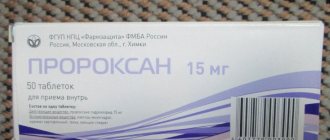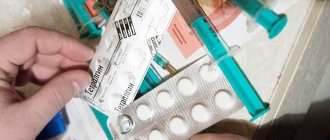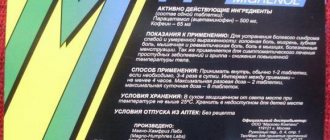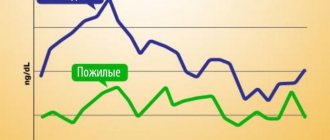Release form and composition
- sugar-coated tablets: round, biconvex, white, almost odorless (10 and 20 pcs. in strip packs, 1 or 2 packs in a cardboard pack);
- rectal suppositories: oblong in shape, with a smooth surface, white or ivory (5 pieces in aluminum foil strips, 2 strips in a cardboard box).
Composition of 1 tablet:
- active substance: hyoscine butyl bromide – 10 mg;
- auxiliary components: colloidal silicon dioxide, dried corn starch, anhydrous calcium hydrogen phosphate (calcium hydrogen phosphate), tartaric acid, soluble corn starch, stearic acid;
- shell: acacia gum (acacia gum), sucrose, carnauba wax, white wax (white beeswax), talc, macrogol 6000 (polyethylene glycol), povidone (polyvinylpyrrolidone), titanium dioxide.
Composition of 1 suppository:
- active substance: hyoscine butyl bromide – 10 mg;
- auxiliary components: solid fat W 45, purified water.
Buscopan price
The average cost of Buscopan No. 20 tablets is 420–500 rubles. The price of rectal suppositories is about the same. You can buy medicine online, thereby saving on your purchase.
| Name of Moscow pharmacy | Price of tablets No. 20, rubles |
| ASNA | 290 |
| Online pharmacy "Dialogue" | 330 |
| Pharmacy chain "36.6" | 365 |
| Evalar | 380 |
| Dialogue | 390 |
| Neopharm | 400 |
| ElixirPharm | 470 |
Pharmacological properties
Pharmacodynamics
Hyoscine butyl bromide is an M-anticholinergic blocker that has a local antispasmodic effect on the smooth muscles of internal organs: the gastrointestinal tract, urinary and biliary tract. It also helps reduce the secretion of the digestive glands.
The local antispasmodic effect of the drug is explained by its antimuscarinic and ganglion-blocking activity. Hyoscine butyl bromide is a quaternary ammonium derivative, does not penetrate the blood-brain barrier, and therefore does not have an anticholinergic effect on the central nervous system.
Pharmacokinetics
After oral administration, hyoscine butyl bromide is slightly absorbed from the gastrointestinal tract - approximately 8%. When administered rectally, absorption is about 3%.
Absolute bioavailability on average is no more than 1%.
After a single oral dose of Buscopan in doses ranging from 20 to 400 mg, mean maximum plasma concentrations are reached within approximately 2 hours and range from 0.11 to 2.04 ng/ml.
Due to its high affinity for nicotinic and muscarinic hyoscine receptors, butyl bromide is distributed predominantly in the muscle cells of the pelvic and abdominal organs, as well as in the intramural ganglia of the abdominal organs.
It is characterized by low binding to plasma proteins (albumin) - about 4.4%. It was found that in vitro at a concentration of 1 mmol the drug interacts with the transport of choline (1.4 nmol) in epithelial cells of the human placenta.
Metabolized mainly by hydrolysis of the ester bond. When taken orally, excretion occurs in urine and feces, intestinal excretion is 90%, renal elimination is 2–5%. Renal excretion of metabolites of the active substance Buscopan is <0.1% of the dose taken. In cases of taking the drug in the dose range from 100 to 400 mg, the average clearance values are 881–1420 l/min, the corresponding volumes of distribution are from 6.13 to 11.3 x 105 l, which can be explained by low systemic bioavailability.
After rectal administration of Buscopan, renal elimination is 0.7–1.6% and occurs mainly through the intestines. Renal excretion of metabolites of the active substance Buscopan is <0.1% of the dose received.
Metabolites that are excreted in the urine weakly bind to muscarinic receptors and are therefore not active and do not have pharmacological properties.
The terminal half-life of the drug after a single oral dose in the range of 100 to 400 mg is 6.2–10.6 hours.
Analogs
If a medication causes side effects, it needs to be replaced . When choosing an analogue of Buscopan, you need to pay attention to the following medications:
- Atrovent. This is a solution for use in lung diseases that are accompanied by bronchospasm. Recommended dose for adults: 2 ml three times a day, but not more than 8 ml. children over 6 years old - 1 ml with the same number of daily approaches.
- Atropine. This is a solution with anticholinergic and antispasmodic effects, which is prescribed for stomach ulcers, pancreatitis, intestinal and hepatic colic. Adults are administered subcutaneously, intramuscularly or intravenously twice a day, 0.25-1 mg.
- Gastrocepin. Two forms of release - tablets for oral use and solution for intravenous and intramuscular injections. The drug reduces the acidity of gastric juice, the course of treatment is up to 2 months. Dosage – 50 mg 2 times a day.
- Gastrozem. This is an antiulcer, gastroprotective agent in the form of tablets for oral administration. The recommended dose is 50 mg twice a day - morning and evening. The medicine is taken 30 minutes before meals, the course is at least 4 weeks.
- Driptan. These are white tablets to reduce the tone of the smooth muscles of the urinary tract. The daily dosage of this medication is 1 tablet 2-3 times a day for several weeks without a break.
- Mydriacyl. These are eye drops needed to reduce muscle tone. In this way, ophthalmologists often examine the fundus of the eye to identify pathologies.
- Novitropan. This is an antispasmodic in the form of tablets for oral use. The need for its use arises in case of urinary incontinence. The recommended dosage is 1 tablet 2-3 times, the maximum is 1 tablet 4 times a day.
- Spasmex. This is a combination drug with an antispasmodic effect in the form of tablets. Each package contains 30 pcs. Tablets with a dosage of 5 mg are prescribed 2-3 pieces 3 times a day. The course of drug therapy is at least 2 months.
- Trigan D. Tablets with antispasmodic, analgesic, anti-inflammatory therapeutic effect. They relieve pain, relieve spasms, and suppress the inflammatory process. Dosage: 1 tablet 2-3 times a day. The maximum single dose is 2 tablets, the daily dose is 4 tablets. The course is several weeks.
Contraindications
- megacolon;
- myasthenia gravis;
- children under 6 years of age;
- period of pregnancy and lactation;
- hypersensitivity to any component of the drug.
Buscopan tablets contain sucrose (41.2 mg per 1 piece), therefore in this dosage form it is contraindicated in cases of glucose-galactose malabsorption and sucrase-isomaltase deficiency, fructose intolerance.
According to the instructions, Buscopan should be used with caution in the following cases:
- urinary tract obstruction (including benign prostatic hyperplasia);
- suspected intestinal obstruction (including pyloric stenosis);
- angle-closure glaucoma;
- tachyarrhythmia, including atrial fibrillation.
Indications for use of Buscopan
According to the detailed instructions, the drug is involved in a complex therapy regimen. This pharmaceutical prescription is recommended for:
- dyskinesia of the bile ducts and gallbladder;
- intestinal and renal colic;
- acute cystitis;
- cholecystitis (inflammation of the gallbladder);
- pylorospasms (contractions of the pylorus);
- exacerbation of stomach and duodenal ulcers;
- algodismenorrhea (pain during menstruation);
- bladder spasms;
- the appearance of harbingers of labor.
Side effects
- from the digestive system: dry mouth;
- from the cardiovascular system: tachycardia;
- from the urinary system: urinary retention;
- from the skin and subcutaneous tissues: dyshidrotic eczema;
- from the immune system: skin reactions (for example, rash, itching, urticaria, erythema), shortness of breath, anaphylactic reactions, anaphylactic shock and other manifestations of hypersensitivity.
Many of the described side effects may be due to the anticholinergic properties of Buscopan; they are usually mild and go away on their own.
Buscopan and alcohol
The combination of this medication with ethyl alcohol is strictly contraindicated. Otherwise, the risk of side effects increases, and the patient’s well-being in a particular clinical case worsens. This applies not only to the interaction of Buscopan with alcoholic beverages, but also with alcohol-containing medications (consultation with a specialist is required).
Overdose
There have been no reports of cases of overdose to date. It is assumed that the development of anticholinergic symptoms, such as dry mouth, urinary retention, transient visual disturbances, redness of the skin, depression of gastrointestinal motility, and tachycardia, is possible.
The effect of the M-anticholinergic blocker is stopped with the help of cholinomimetics. Patients with glaucoma are prescribed pilocarpine in the form of eye drops. If the need arises, systemic cholinomimetics are used, for example, neostigmine intravenously or intramuscularly at a dose of 0.5–2.5 mg. Complications from the cardiovascular system are treated in accordance with the usual therapeutic rules. In cases of urinary retention, catheterization of the bladder is indicated. In case of paralysis of the respiratory muscles, intubation and artificial ventilation are required. Maintenance therapy is necessary.
Buscopan oral tablets
Instructions for medical use of the drug
Description of pharmacological action
It has an antispasmodic effect on the smooth muscles of internal organs and reduces the secretion of the digestive glands. Being a quaternary ammonium derivative, it does not pass through the BBB, therefore it does not have an anticholinergic effect on the central nervous system.
Indications for use
- renal colic; - biliary colic; - spastic dyskinesia of the biliary tract and gallbladder; - cholecystitis; - intestinal colic; - pylorospasm; - peptic ulcer of the stomach and duodenum in the acute phase (as part of complex therapy); - algodismenorrhea.
Release form
sugar-coated tablets 10 mg; blister 20, cardboard pack 1; sugar-coated tablets 10 mg; blister 10, cardboard pack 2; sugar-coated tablets 10 mg; blister 10, cardboard pack 1; sugar-coated tablets 10 mg; blister 20, cardboard pack 2; Composition: Sugar-coated tablets 1 tablet. hyoscine-N-butyl bromide 10 mg excipients: dibasic calcium phosphate; corn starch; soluble starch; colloidal silicon dioxide; tartaric acid; stearic acid/palmitic acid shell: PVP; sucrose; talc; gum arabic; titanium dioxide; polyethylene glycol 6000; carnauba wax; white wax in a blister 20 pcs.; 1 blister in a box. Suppositories for rectal use 1 sup. hyoscine-N-butyl bromide 10 mg excipients: purified water; fat W45 solid in a strip 5 pcs.; There are 2 strips in the box.
Pharmacodynamics
It has an antispasmodic effect on the smooth muscles of internal organs and reduces the secretion of the digestive glands. Being a quaternary ammonium derivative, it does not pass through the BBB, therefore it does not have an anticholinergic effect on the central nervous system.
Pharmacokinetics
Data on the pharmacokinetics of the drug Buscopan in the form of suppositories are not provided.
Use during pregnancy
There is no evidence of a negative effect of the drug on pregnancy. However, as with other medications, caution should be exercised when prescribing the drug during pregnancy, especially in the first trimester. The safety of prescribing the drug during lactation has not yet been proven, but no cases of adverse effects have been reported in newborns.
Contraindications for use
- hypersensitivity to hyoscine-N-butyl bromide or any other component of the drug; - angle-closure glaucoma; - myasthenia; - megacolon; - pulmonary edema; - severe atherosclerosis of cerebral vessels.
Side effects
Dry mouth, dry skin, tachycardia, drowsiness, accommodation paresis; urinary retention is possible, which is usually not pronounced and resolves on its own. Very rarely - hypersensitivity reactions with skin manifestations; extremely rarely, difficulty breathing has been reported.
Directions for use and doses
Orally (tablets), unless otherwise prescribed, adults and children over 6 years old - 1-2 tablets. 3 times a day, washed down with water. Rectally (suppositories), unless otherwise prescribed, adults and children over 6 years old - 1-2 suppositories. 3 times a day. Suppositories should be removed from the shell and inserted into the rectum with the pointed end first. The duration of use is determined by the doctor.
Overdose
To date, cases of overdose with Buscopan® have not been described, therefore the symptoms and recommendations below may be associated with its pharmacological effect and are of a theoretical nature. Symptoms: urinary retention, dry mouth, redness of the skin, tachycardia, decreased gastrointestinal motility, transient visual impairment. Treatment: gastric lavage with activated carbon and then with 15% magnesium sulfate (in case of an overdose of tablets). Symptoms of overdose are relieved with cholinomimetics. Patients with glaucoma are prescribed topical pilocarpine in the form of eye drops. If necessary, cholinomimetics are administered systemically, for example neostigmine 0.5–2.5 mg IM or IV. Cardiovascular complications are treated according to the usual therapeutic rules. In case of paralysis of the respiratory muscles, intubation and mechanical ventilation are indicated. In case of urinary retention, the bladder is catheterized. Maintenance therapy is carried out.
Interactions with other drugs
May enhance the anticholinergic effect of tricyclic antidepressants, antihistamines, quinidine, amantadine and disopyramide. The simultaneous administration of Buscopan® and dopamine antagonists, such as metoclopramide, leads to a weakening of the effect of both drugs on the gastrointestinal tract. Buscopan® may increase tachycardia caused by beta-adrenergic agents.
Precautions for use
Prescribed with caution in cases of suspected intestinal obstruction (including pyloric stenosis), urinary tract obstruction (including prostate adenoma), in patients with a tendency to tachyarrhythmias (including atrial fibrillation); persons whose profession requires concentration and speed of psychomotor reactions.
Storage conditions
At a temperature not exceeding 25 °C.
Best before date
60 months
ATX classification:
A Digestive tract and metabolism
A03 Drugs for the treatment of functional disorders of the gastrointestinal tract
A03B Belladonna and its derivatives
A03BB Semi-synthetic belladonna alkaloids, quaternary ammonium compounds
A03BB01 Butylscopolamine
special instructions
Seek medical help immediately if, while using Buscopan, abdominal pain of unknown origin persists or worsens, or the following symptoms appear: nausea, abdominal tenderness, changes in stool consistency and frequency of bowel movements, blood in the stool, vomiting, decreased blood pressure, fever, fainting .
Impact on the ability to drive vehicles and complex mechanisms
The effect of Buscopan components on human cognitive and psychomotor functions has not been studied.
Drug interactions
Hyoscine butylbromide may potentiate the tachycardia caused by beta-adrenergic agents.
With simultaneous use of dopamine antagonists (for example, metoclopramide), a mutual weakening of the effect on the gastrointestinal tract is observed.
Buscopan may enhance the anticholinergic effect of anticholinergic drugs (for example, atropine-like compounds, ipratropium bromide, tiotropium bromide), antipsychotics and antihistamines, tetracyclic and tricyclic antidepressants, amantadine, disopyramide and quinidine.
Reviews of Buscopan
Reviews of Buscopan in tablet form are contradictory. Some patients confirm the high effectiveness of the drug for spasms of the smooth muscles of internal organs, while others, on the contrary, write about the insufficient effect or its complete absence.
Reviews of Buscopan suppositories are most often found on thematic women's forums. In this dosage form, the drug is usually used by women for painful menstruation (algomenorrhea). Although suppositories are not intended for use during pregnancy, doctors often prescribe them before childbirth to prepare the cervix. In these cases, the opinions of the patients were also divided: it helped some, but not others.
Directions for use and dosage
Buscopan tablets are intended for oral use, suppositories - for rectal administration . The doctor determines the course of drug therapy on an individual basis. Treatment is carried out for patients over 6 years of age in the absence of medical contraindications. Self-medication aggravates the clinical picture and provokes side effects.
Articles on the topic
- Omnik - instructions and mechanism of action, contraindications, side effects, dosage regimen and analogues
- Duspatalin - instructions for use and contraindications, mechanism of action, side effects and analogues
- Rowatinex - instructions for use, dosage, mechanism of action, contraindications and reviews
Buscopan candles
Before inserting the suppository into the rectum, it is necessary to cleanse the intestines of accumulated feces at home. It is advisable to carry out the procedure in a horizontal position and do not stand up afterwards. Buscopan treatment regimen: 1 suppository rectally three times a day. The doctor prescribes the recommended course of drug therapy individually. For algodismenorrhea and other situational pain, one-time use without repetition is possible, after the manifestations of the syndrome have gone away.
Buscopan tablets
This release form is intended for oral administration. It is recommended to swallow the tablets whole, without chewing, with plenty of water. Recommended dose – 1-2 pcs. three times a day. If after several days of conservative treatment there is no positive dynamics at all, it is necessary to replace the medication with an analogue on the recommendation of the attending physician. It is not recommended to take the medication on an empty stomach, otherwise it can cause irritation of the mucous membrane.




